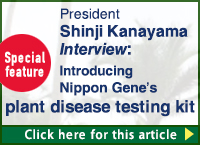Tomato
Tomato, which is an indispensable part of people’s diet, ranks among the top crops and is cultivated by many farmers. The higher the number of cultivated tomatoes, the higher the risk of plant disease.
Because tomatoes have many diseases and each disease requires different countermeasures to cure, identifying the cause of the disease is an effective way to prevent the spread of infection.
Nippon Gene has an extensive lineup of genetic test kits that test the causes of tomato diseases with high sensitivity.
Tomato yellow leaf curl virus (TYLCV)
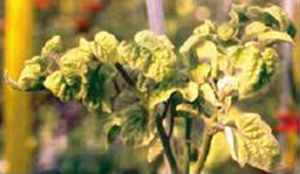
- Plant viruses that infect solanaceous plant such as tomatoes
- Mediated by Bemisia tabaci (tobacco whitefly)
- It is important to find and discard infected tomatoes at an early stage
Tomato yellow leaf curl virus (TYLCV) is the causative virus of tomato yellow leaf curl disease. Tomatoes infected with tomato yellow leaf curl virus cause poor growth due to leaf yellowing or dwarf, resulting in a decrease in tomato yield.
Currently, various virus control measures are being taken, but since the whiteflies which carry viruses are very small pests that are difficult to detect and disinfect, the crop damage continues to grow in various places.
Since it is a difficult disease to control, early control measures are necessary such as extermination of tobacco whiteflies, and disposal of infected strains upon identification of the disease at an early stage.
Detection Kit
TYLCV Detection Kit
A diagnostic kit that detects tomato yellow leaf curl virus.
* The linked page may be in Japanese, please use the translation function of the browser.
Detection Service
Tomato Yellow Leaf Curl Disease Testing Service
A service to check the presence of tomato yellow leaf curl virus from the tomato leaves that you provide.
* The linked page may be in Japanese, please use the translation function of the browser.
Tobacco whitefly biotype Q
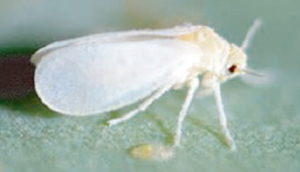
- Insects that carry plant viruses
- Resistant to pesticides
- Very small insects which is too small to see, so genetic testing can be helpful
Tobacco whiteflies are important pest for vegetables and flowers, and insects that carry plant disease viruses such as tomato yellow leaf cigar virus.
Tobacco whiteflies are classified into multiple biotypes, and biotype B (silver leaf whiteflies) and biotype Q have been confirmed in Japan in addition to the conventional strain (biotype JpL).
Biotype Q is a drug-resistant population with low sensitivity to the pesticides such as pyriproxyfen, neonicotinoids, and synthetic pyrethroids, which were highly effective against biotype B. Therefore, it is necessary to take effective control measures against biotype Q.
Biotype B and Q are not distinguishable by their appearance, so genotype testing is effective for its detection.
Detection Kit
Bemisia tabaci Q biotype Detection Kit
A diagnostic kit that determines the biotype of Bemisia tabaci.
* The linked page may be in Japanese, please use the translation function of the browser.
Thermophilic Pythium spp.
- Pathogenic bacteria that may cause serious damage in hydroponics farms
- Infection risk increases especially when growing during high temperatures
- Frequent inspection of the culture solution can reduce damage in advance
Pythium spp. are the target of pest control as a pathogen that cause plant seedling wilt and root rot in soil and hydroponics. Among the genus Pythium, the genus Pythium that can grow at a high temperature of about 38 °C is called “thermophilic Pythium genus”, which is a major problem as a cause of waterborne infectious diseases in hydroponics.
There are three types of thermophilic Pythium species, Pythium helicoides, Pythium myriotylum, and Pythium aphanidermatum, and their pathogenicity vary depending on the kind of plant.
In hydroponic culture facilities, there is a risk that thermophilic Pythium bacteria may spread throughout the facility via the culture medium. Therefore, it is recommended to periodically inspect the culture solution in conjunction with controlling the temperature and culture solution temperature.
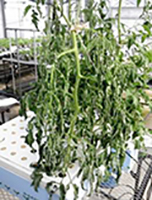
Dwarf symptoms of tomato root rot
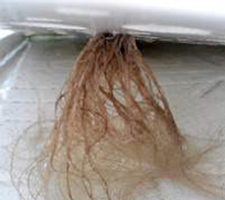
Roots rotted in water by a tomato root rot fungus
Photo courtesy of Mie Prefecture Agricultural Research Institute
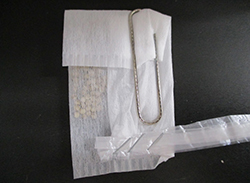
An “perilla trap” made from perilla seeds
Pythium spp. have the property of gathering in oilseed perilla.
Utilizing these characteristics, an “perilla trap” made from perilla seeds can be installed in any location (nutritional solution tank, cultivation bed, etc.) in the nutrient solution cultivation facility, and the baited thermophilic Pythium bacteria can be genetically tested for detection.
If high-temperature Pythium is detected, take appropriate measures according to the “Safety Diagnosis Manual for High-temperature Waterborne Infectious Diseases in Hydroponic Culture”.
Detection Kit
LAMP Primer Set for Pythium
A primer set for LAMP method that detects thermophilic Pythium.
* The linked page may be in Japanese, please use the translation function of the browser.
PepMV: pepino mosaic virus
- Plant viruses that infect solanaceous plant such as tomatoes
- Plant viruses which is under quarantine restriction in Japan
- Primer set useful for quarantine inspection, and infection check
Pepino mosaic virus (PepMV) is a plant virus that is classified as a potyvirus that has been reported to infect mainly solanaceous plants such as tomatoes, potatoes, and pepinos.
When the virus infects tomatoes, mosaic symptoms on the fruits, delayed maturation, etc. are observed, leading to a reduction in the quality of fruit. As infection routes, seed propagation by contaminated seeds and contact propagation by agricultural work have been reported.
Pepino mosaic virus (PepMV) has been designated as a quarantine pest and is an extremely important plant pathogen that causes great damage in tomato cultivation when brought into Japan.
Detection Kit
LAMP Primer Set for PepMV (Pepino Mosaic Virus) Detection
A primer set for LAMP method that detects Pepino Mosaic Virus.
* The linked page may be in Japanese, please use the translation function of the browser.



